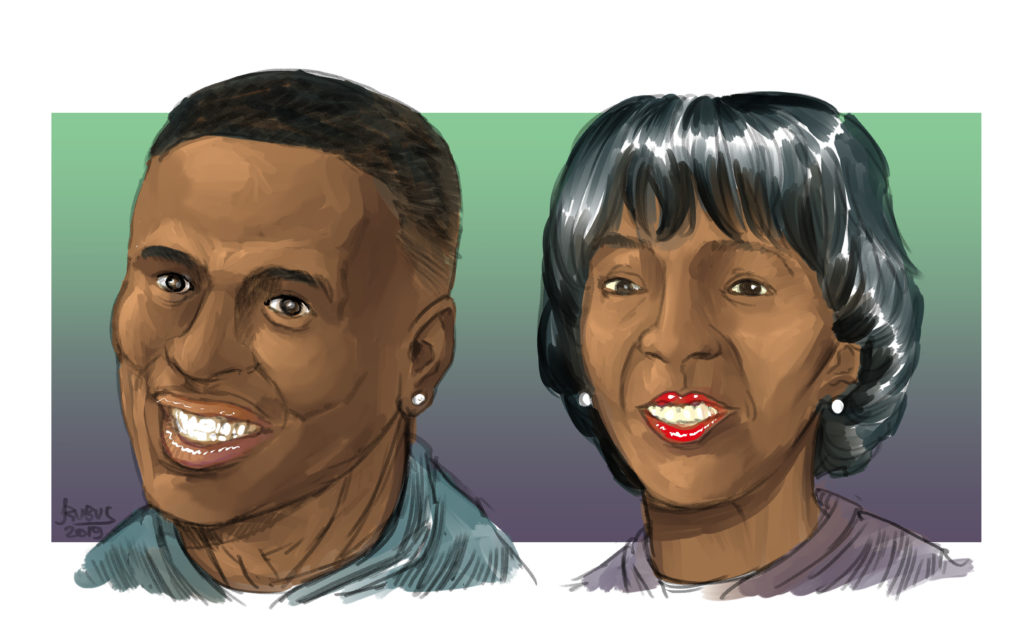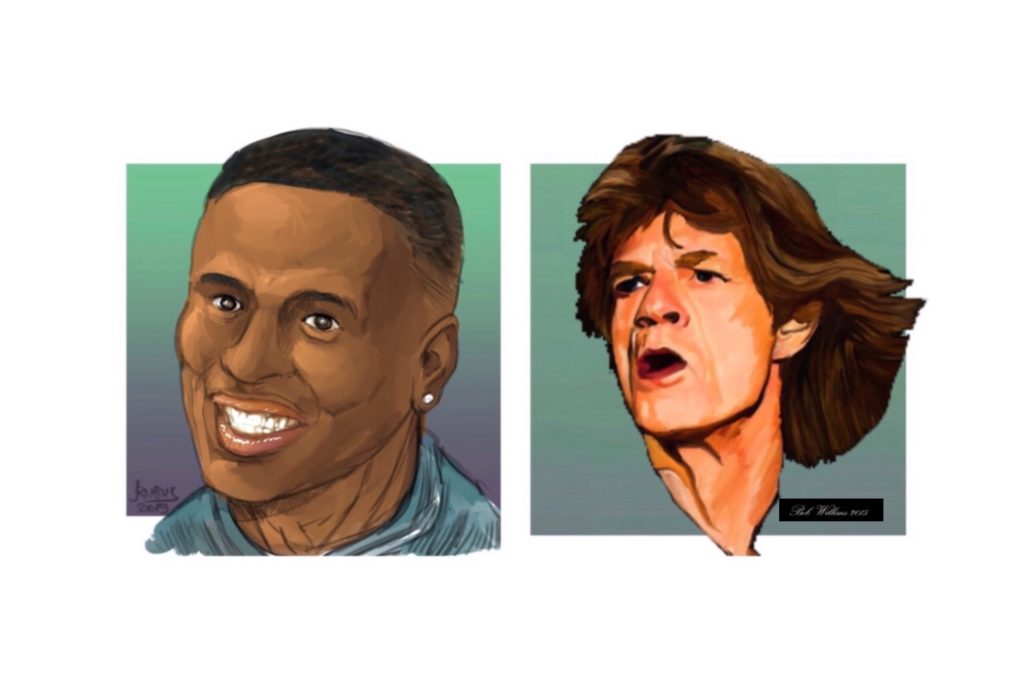Today we update and reprise two stories that we published about the legal troubles faced by Los Angeles Rapper Drakeo the Ruler, who was born Darrell Caldwell, and who spent over 3 years in an L.A. Jail through one trial and pending a second trial.
In those articles, we explored both the political and cultural dimensions to Drakeo’s case. Since that time Drakeo released a critically acclaimed album recorded over a jail-house phone, and he accepted a plea bargain on a remaining Gang Conspiracy charge. That deal, according to journalist Jeff Weiss, set him free on parole, the conditions of which “will last five years, and any minor violation could lock him up again for nearly a decade.”
In an interview with Drakeo conducted for The Ringer, Weiss asked: “How difficult was it to take a plea for something that you didn’t do?”
Drakeo responded: “Oh boy, I did not want to take that plea. I still feel like it’s a setup; they want me to get into trouble. They feel like this is a win for them. I still had to plead out; they still got the gang enhancement. I still have the same judge, so that means if something happens, she’s going to be the one who sentences me to the nine years that’s hanging over my head.”
Drakeo’s path after liberation may be haunted by the spectre of a familiar paradigm. Superstar rapper Meek Mill endured a famously fraught experience at the hands of Philadelphia trial judge Genece Brinkley, who repeatedly accused Meek of violating the rules of his probation and jailed him for 6 months for such alleged violations until public scrutiny of irregularities in the case appeared to prompt his release.
During an interview on the Power 106 Morning Show, Drakeo and hosts Teddy Mora and DJ Carisma summarized his understanding of the precariousness of his situation:
Teddy Mora:
2017, do I got the year right?
Drakeo the Ruler:
Yeah, that’s when I first went to jail.
Teddy Mora:
When you first went to jail, right, and because of a California law that a lot of people don’t know, which your situation brought to light… they were able to keep you in and try to charge you because they said that your environment allowed for violence to happen. It- it, uh, do- do I got in a nutshell?
Drakeo the Ruler:
Yeah. Yeah, yeah, that’s exactly right. That’s exactly the interpretation of it, and their best, their… saying that, you know, since I know people are like, this just goes for anybody, you can know a friend or somebody you went to school with, and basically, they say since you know about them doing… stuff or even stuff they might not do… that they were able to try to charge me for something that I didn’t do, to say that I benefited from it because I know people who commit crimes
…
Teddy Mora :
Did you have to, like, take a minute to really un- like, whoa, I’m getting out today for real?
Drakeo the Ruler:
Yeah, that’s why, like, I didn’t, I didn’t really believe them because I’m like, bro, I was fighting the death penalty…
Teddy Mora:
Damn.
Drakeo the Ruler :
…and then all of a sudden they just like, “Oh, yeah, well… you can go home today.” It just… didn’t feel real. I’m like, no, they gotta be playing. It gotta be something else, and then I got out… It’s just crazy, like, a-ha, all of a sudden, like… These people are evil.
Below are the Crime Story articles from almost exactly one year ago: Drakeo the Ruler and the LA District Attorney Election by me, Kary Antholis, and Paint it Black: Drakeo the Ruler, Mick Jagger and “Gang Conspiracy” by Molly Miller.

Drakeo the Ruler and the LA District Attorney Election
by Kary Antholis, November 19, 2019
“Right now young men who sing and rap and rhyme are suffering for their ability to say what they want to. We all benefit from the artists who push the boundaries of speech, and so as a country we should see a collective interest in protecting them. This is especially true for artists who criticize the state, because once the state — which is supposed to be a representation of the people — is above reproach, we are entering Orwellian waters. That scares the shit out of me.”
Excerpt From Michael Render’s (aka Killer Mike’s) Foreword to Rap on Trial by Erik Nielson and Andrea L. Dennis
In the city of Los Angeles, there’s a man who was tried and found not guilty of murder and attempted murder. But that man currently spends all but seven hours a week locked in solitary confinement.
That man’s given name was Darrell Caldwell. He is better known as the emerging Los Angeles rap artist Drakeo the Ruler.
At his last trial, the prosecutor, Shannon Cooley, argued that Drakeo’s group, called the Stinc Team, is a violent gang, and then Cooley proceeded to use the artist’s work against him. “As his moniker suggests, he is the leader … They rap about their crimes,” she said.
The lead detective on the case, Francis Hardiman, told the court that he employs “the greatest crime-fighting tools on earth – Google and social media” and explained how he used the artist’s work to build a case against him.
Although Drakeo was acquitted on the murder and attempted murder charges, he is still in jail because he was convicted on a felony gun charge, because the jury was hung on the counts of gang conspiracy, and because the prosecution intends to try him again.
Drakeo is in solitary confinement awaiting trial because he posted on social media:
“I NO LONGER WANNA BE A RAPPER ANYMORE. THANK DETECTIVE HARDIMAN FOR TRYNA USE MY LYRICS AGAINST ME. I WILL BE PULLING ALL MY MUSIC DOWN TOMORROW. U CRUSHED MY DREAMS #THANKDETECTIVEHARDIMAN”
Drakeo’s post provoked some of his fans to post threatening messages towards Detective Hardiman and it was Hardiman who successfully sought to have Drakeo placed in solitary.
Drakeo’s trial was scheduled to begin last week, but has been postponed until the new year. There has been some excellent coverage of this case. The most intimate and emotionally impactful has been the reporting by Jeff Weiss in The Fader. CRIME STORY will cover Drakeo’s new trial early next year and later this week, we will be posting an article that uses this case to delve into the use of California’s Gang Conspiracy laws to prosecute artists of color. But I would like to take a moment to discuss the political ramifications of this case for the upcoming race for Los Angeles District Attorney.
Jackie Lacey is up for reelection within the next year. It has been well documented that she faces an uphill battle. There is increasing political momentum – particularly in traditionally Democratic communities – behind the candidacies of those who advocate for decarceration, an end to cash bail, prosecution of criminal police officers, and the prevention of police with a track record of mendacity from testifying in court. We cited this phenomenon in The Chrissy Teigen Tweet and Trump’s Turn Away from Criminal Justice Reform.
Chesa Boudin, the newly elected District Attorney in San Francisco, is among the most aggressive of this new breed of prosecutors in his ambitions and his planned tactics aimed at meaningful and expedited prosecutorial reform.
In a recent interview on the Aider and Abettor Podcast, Boudin said, “I want to eliminate racist gang enhancement allegations. I think if someone is in a criminal street gang, and they commit a serious crime, they can be prosecuted for the serious crime. But the way that gang enhancement allegations have been used historically and even currently in San Francisco and in so many other parts of the country is really aimed at criminalizing an entire culture and shoehorning into evidence in front of a jury a tremendous amount of irrelevant but highly prejudicial social media and family relationships… so that’s another thing we’re going to do right away. End the use of racist gang enhancement allegations.”
Meanwhile, Jessica Pishko, a lawyer and writer about incarceration and social justice issues, just last week penned an OpEd in The Appeal in which she suggested that Jackie Lacey “has largely disappointed those who looked to the new, Black, female and Democratic district attorney to enact change. And, over time, once progressive prosecution ideas have become mainstream and Lacey seems woefully behind, in the model of the same tough-on-crime DA that residents had experienced for decades.” Pishko later related the consensus of advocates who feel that Lacey is “in the best position to help regulate some of the worst excesses of the LAPD, a law enforcement agency with a long history of oppressing communities of color, but hasn’t done so.”
While the activist community seems to have made up its mind about Lacey’s legacy, it is not yet clear that the general voting population in Los Angeles is ready to vote her out of office. Yet, just as the OJ Simpson trial revealed a severe disconnect between Gil Garcetti’s DA office and the Los Angeles community, there may be a case that galvanizes the LA voters to take a more progressive turn in the DA election.
If popular LA Hip Hop artists like Dre or Snoop or Kendrick begin to get their fans activated about Drakeo’s case… if Kim or Kanye advocate on his behalf, the blowback on Lacey’s campaign could be politically devastating.
I began this piece with a quote from Killer Mike’s Foreword from Rap on Trial, and I will close with another quote from that same piece:
“Prosecutors know that locking up young men of color carries political capital, and they’ve figured out a way to use rap lyrics to do it. Right now, aspiring rap artists need to know they are being targeted by the authorities, and they need to balance their right to free speech — and their desire to push the envelope of free speech — with the reality that police are watching. ”

Paint it Black: Drakeo the Ruler, Mick Jagger and “Gang Conspiracy”
by Molly Miller, November 22, 2019
This article contains a summary of Darrell Caldwell aka Drakeo the Ruler’s criminal case. For a thorough and moving examination of past proceedings we recommend Jeff Weiss’ piece on The Fader.
The Rolling Stones are a criminal street gang.
At least they could be considered a criminal street gang under California’s modern gang legislation if it were applied to the band’s behavior in the ‘60s and ‘70s.
I don’t mean to offend the fans of almighty dad rock or demonize the band that recorded the album Their Satanic Majesties Request. My aim is to illuminate an enigma in The Golden State’s penal codes: the definition of a criminal street gang, which is so broad and loose that it may as well be painted with broad strokes over the doorway of every home in South LA.
Paint it black. Black and Brown.
The Stinc Team is not the Rolling Stones. The LA street rap group would probably loathe the comparison. Their frontman, Drakeo the Ruler (real name Darrell Caldwell), does not have a mouth large enough to eat an alarm clock whole. His style is understated; lyrics are served like insults mumbled under his breath.
According to major players in the hip-hop scene, Drakeo should be reinvigorating LA rap right now, but he’s been stuck in jail since March 28, 2019 on charges related to a murder that detectives and prosecutors all admit he did not commit.
The crime at the heart of this perplexing saga occurred on December 10, 2016 at a “Naughty or Nice Pajama Jam” in Carson, California. Near midnight, the raucous holiday festivities were interrupted by the sound of gunshots. Over 160 party-goers fled to the streets, leaving in their wake two wounded and one dead.
The single fatality was 24-year-old Davion Gregory, a young man with a bright smile. He had familial ties to the Bloods and was known to his friends as “Red Bull.” Gregory sustained five shots to his vital organs and was pronounced dead upon arrival at Harbor UCLA Medical Center. No witnesses were immediately able to identify the shooter, and security footage was too dark to distinguish the faces of the man who may have committed the crime.
According to California Penal Code 186.22, often referred to as the Street Terrorism and Prevention Act or STEP ACT, a “criminal street gang” must meet the following criteria:
1. Be an ongoing organization of three or more persons
2. Have a common name or common identifying sign or symbol
3. Have as one of its primary activities the commission of one or more criminal acts
4. Collectively engage in a pattern of criminal gang activity
The Rolling Stones consists of Mick Jagger, Keith Richards, Charlie Watts and Ronnie Wood. In other words, it’s an organization of three or more people.
The Rolling Stones also have a common name: The Rolling Stones. Their sign/symbol is a massive cherry-lipped mouth with a tongue lolling out of it.
The Rolling Stones have committed criminal acts including assaulting a peace officer, possession of illicit substances, and possession of an illegal firearm.
Their criminal acts between 1967 and 1976 might qualify as a pattern.
On the night of the shooting, Drakeo was chilling at his apartment with members of the Stinc Team: Ralfy the Plug, Solo, Philly, Kellz, Young Bull and Ketchup the Great. They spotted the Pajama Jam party on Instagram and decided to stop by. Drakeo drove his black Benz with Solo and Kellz. The rest of the Stinc Team caravanned behind them. According to Solo, when they pulled into the parking lot, their friend 2Shitty informed them that the Inglewood Families (The Bloods) were there.
Seconds later, Davion Gregory walked by and shots were fired. 2Shitty later told cops that the first shooter was Jaiden Boyd, a Rollin 40s Crip who goes by the nickname of AB or Arlington Blue. When Boyd was arrested he admitted to pulling the trigger on Gregory, explaining that they had “beef” with each other. He also implicated a second shooter, Stinc Team member, Kellz.
That should have been enough for detectives in search of the truth. Two Crips killed a Blood. The Montagues and Capulets of Compton once again made the concrete bleed. But it seems that law enforcement and the DA in this case were after a bigger prize: they wanted to take down the Stinc Team, especially Drakeo the Ruler.
The DA has filed a litany of charges against the Stinc Team members ranging from felony vandalism to burglary to felon possession of a firearm, but Drakeo was clearly the DA’s primary target. Prosecutors set out to charge Drakeo under California’s Criminal Conspiracy laws (182 PC). which state that “If two or more persons conspire…to commit any crime…it shall be punishable in the same manner and to the same extent as is provided for the punishment of that felony.” Prosecutors argued that Drakeo conspired with Kellz and AB to commit murder prior to the party. Therefore, Drakeo was charged with murder as well as several counts of attempted murder and shooting from a vehicle. All of these charges were filed despite the fact that Drakeo never fired a single bullet.
There was one glaring problem with the conspiracy theory: the DA and the detectives had no evidence that Drakeo ever wanted to kill Davion Gregory. No Facebook messages. No Instagram videos. No coded rap lyrics. Nothing connected the individuals in a credible equation that could add up to conspiracy to commit murder.
This problem was solved when Detective Francis Hardiman developed the RJ theory. RJ is a rapper who did have beef with Drakeo. He’s a bit older than Drakeo, but the two rap in a similar way, both spitting about LA “street shit.” Unsurprisingly, they’ve been pitted against each other —flexing on Instagram, in interviews, and in their freestyle rap videos about who really runs the streets. In one video, Drakeo taunts his rival saying “I’m ridin round town with a tommy gun and Jag/ And you can disregard the yelling, RJ tied up in the back.” Hardiman used the social media squabbles and lyrics as the foundation for his argument that Drakeo gave Kellz and AB their guns and drove to the party on a mission to kill RJ. Davion Gregory, under this theory, was an unanticipated fatality in a larger conspiracy.
In case you’re wondering, RJ wasn’t at the party. He wasn’t even on the flier.
Presumption of Drakeo’s guilt seemed to march before the evidence like a grand marshal. The prosecution’s argument reeked of bad science: a conclusion was determined, then data was arranged to point to it with a neon arrow.
The jury saw through the legal smokescreen. After a month-long trial, Drakeo was acquitted of the majority of his charges, including criminal conspiracy, attempted murder and murder. He was found guilty of felon possession of a firearm and the jury was split on the charges of discharging a firearm from a vehicle and criminal gang conspiracy.
Conventional wisdom would have you believe that Drakeo’s case was finished. The jury had spoken. Drakeo would serve time for his firearm possession charge and then be free to take his throne on the outside as one of rap’s rising stars. But in the criminal legal process, conventional wisdom is often wrong.
The DA refiled the charges on which the jury hung. Now Drakeo is back in jail and preparing to face trial again in January.
If convicted, he could face a life sentence for a murder that he did not commit and for which a jury has already acquitted him.
The STEP Act defines a “pattern of criminal gang activity” as the attempt, conspiracy to commit, or conviction of two or more specified criminal offenses. The list of specified criminal offenses contains 33 different crimes, most of which are felony offenses ranging from felony vandalism (vandalism resulting in more than $400in damages) to first-degree murder. To establish a pattern, the last of the offenses must have occurred within three years after a prior offense and the offenses must have been committed on separate occasions or by two or more persons.
The following is the Rolling Stone’s “pattern of criminal activity.”
1967: Mick Jagger and Keith Richards were arrested while partying at Richard’s mansion. Jagger was charged with possession of methylamphetamine hydrochloride, their friend Robert Fraser was charged with possession of heroin, and Keith Richards was charged with allowing his house to be used for the purpose of smoking marijuana.
1972: Mick Jagger and Keith Richards were arrested after getting into a fight with a photographer at an airport in Warwick, Rhode Island. After a long flight, Richards was pissed when photographer Andy Dickerman of the Province Journal-Bulletin insisted on a picture. When Dickerman snapped his camera, Richards whipped off his belt and went after him. An officer attempted to pry Richards away, but Jagger jumped on him from behind. The resulting brawl left the policeman with a dislocated shoulder and ended with five men in custody, including Jagger and Richards.
1973: Keith Richards was arrested after officers found Chinese heroin, mandrax tablets, marijuana, a revolver, a rifle and 100 rounds of ammunition in his London home.
Other minor offenses include Mick Jagger and Marianne Faithfull’s arrest for possession of marijuana in 1968 and guitarist Brian Jones’ arrests for marijuana possession in 1967 and 1968.
The legal reason that Drakeo can be charged yet again for a murder everyone agrees he did not commit — a murder which a jury agreed he did not even conspire to commit — is the criminal gang conspiracy law.
Criminal gang conspiracy is a limb of California’s STEP Act. The law’s gang enhancements can look like innocuous add-ons in comparison to more visceral elements of the case. The prosecution plays a slight of hand, making the jury gaze at the crime and forget about those pesky legal accouterments. But after a conviction, STEP enhancements can add 2 – 15 years to a sentence. In some cases, the STEP Act even extends a sentence to life in prison.
But in Drakeo’s new trial, the STEP Act is not simply an additional charge used to inflate sentencing: it is the charge.
Criminal gang conspiracy law states that “any person who actively participates in any criminal street gang…with knowledge that its members engage or have engaged in a pattern of criminal gang activity…and who willfully promotes, furthers, assists, or benefits from any felonious criminal conduct by members of that gang is guilty of conspiracy to commit that felony.” Those convicted of criminal gang conspiracy may be punished in accordance with conspiracy law – the law which generally punishes conspirators to the same degree as the offenders themselves.
Prosecutors are now arguing that the Stinc Team is a gang. Their members have committed burglaries, vandalism, and now murder. Drakeo, as their leader, purportedly benefitted from their crimes. Therefore he can be punished for them.
It doesn’t matter that Drakeo didn’t plan the murder.
It doesn’t matter that he didn’t pull the trigger.
It doesn’t matter that RJ wasn’t at the party.
It doesn’t matter that Drakeo claims his lyrics are just music – not a diary.
All that matters is that Drakeo is in a “gang” and that one of the members killed a man.
It’s guilt by association at the most basic level.
With such legislative logic, if Keith Richards shot a man in the 1970’s, Mick Jagger would be held legally responsible for the crime. During the trial, the prosecutors would point to the band’s criminal history, the drug arrests, aggravated assault, and illegal firearms possession. They would sneer at the red-lip, tongue-y logo and the band’s name that alludes to rugged bad boy transience. Imagine the deputy DA throwing up lyrics on a projector. “‘Sympathy for the Devil!’ This man spits in the face of God himself.” Follow that with insinuations that Mick Jagger committed all those crimes that he brags about in his song. He aided and abetted Pilate in the killing of Christ. He slaughtered the Romanovs while Anastasia screamed in vain. He held a general’s rank during Hitler’s Blitzkrieg. He killed the Kennedys!
But that never would happen.
Like most thought experiments, the screws turn loose upon closer inspection. The Rolling Stones got away with most of their criminal activity. Most of Jagger and Richards’ drug possessions were ultimately reduced to misdemeanors or dismissed. When they assaulted the cop at the airport, the mayor bailed them out and they got a police escort to their concert at Boston Garden.
There’s a reason calling the Rolling Stones a criminal street gang seems so strange.
It’s not because they’re British.



